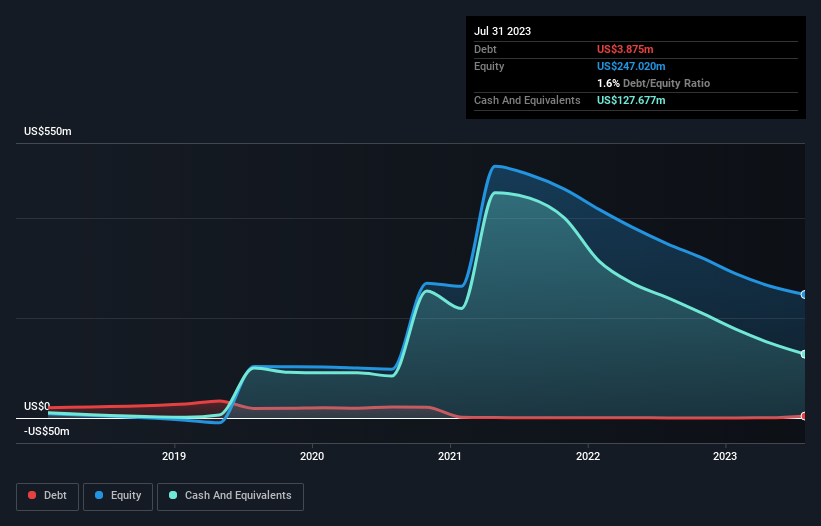David Iben put it well when he said, 'Volatility is not a risk we care about. What we care about is avoiding the permanent loss of capital.' When we think about how risky a company is, we always like to look at its use of debt, since debt overload can lead to ruin. We note that Phreesia, Inc. (NYSE:PHR) does have debt on its balance sheet. But should shareholders be worried about its use of debt?
When Is Debt A Problem?
Debt assists a business until the business has trouble paying it off, either with new capital or with free cash flow. If things get really bad, the lenders can take control of the business. However, a more frequent (but still costly) occurrence is where a company must issue shares at bargain-basement prices, permanently diluting shareholders, just to shore up its balance sheet. Of course, the upside of debt is that it often represents cheap capital, especially when it replaces dilution in a company with the ability to reinvest at high rates of return. The first step when considering a company's debt levels is to consider its cash and debt together.
View our latest analysis for Phreesia
What Is Phreesia's Net Debt?
The image below, which you can click on for greater detail, shows that at July 2023 Phreesia had debt of US$3.88m, up from US$158.0k in one year. However, it does have US$127.7m in cash offsetting this, leading to net cash of US$123.8m.

A Look At Phreesia's Liabilities
Zooming in on the latest balance sheet data, we can see that Phreesia had liabilities of US$84.9m due within 12 months and liabilities of US$8.55m due beyond that. Offsetting these obligations, it had cash of US$127.7m as well as receivables valued at US$53.9m due within 12 months. So it can boast US$88.2m more liquid assets than total liabilities.
This surplus suggests that Phreesia has a conservative balance sheet, and could probably eliminate its debt without much difficulty. Simply put, the fact that Phreesia has more cash than debt is arguably a good indication that it can manage its debt safely. When analysing debt levels, the balance sheet is the obvious place to start. But it is future earnings, more than anything, that will determine Phreesia's ability to maintain a healthy balance sheet going forward. So if you're focused on the future you can check out this free report showing analyst profit forecasts.
In the last year Phreesia wasn't profitable at an EBIT level, but managed to grow its revenue by 30%, to US$319m. With any luck the company will be able to grow its way to profitability.
So How Risky Is Phreesia?
By their very nature companies that are losing money are more risky than those with a long history of profitability. And in the last year Phreesia had an earnings before interest and tax (EBIT) loss, truth be told. Indeed, in that time it burnt through US$85m of cash and made a loss of US$152m. But the saving grace is the US$123.8m on the balance sheet. That means it could keep spending at its current rate for more than two years. Phreesia's revenue growth shone bright over the last year, so it may well be in a position to turn a profit in due course. Pre-profit companies are often risky, but they can also offer great rewards. There's no doubt that we learn most about debt from the balance sheet. But ultimately, every company can contain risks that exist outside of the balance sheet. For instance, we've identified 3 warning signs for Phreesia that you should be aware of.
When all is said and done, sometimes its easier to focus on companies that don't even need debt. Readers can access a list of growth stocks with zero net debt 100% free, right now.
New: Manage All Your Stock Portfolios in One Place
We've created the ultimate portfolio companion for stock investors, and it's free.
• Connect an unlimited number of Portfolios and see your total in one currency
• Be alerted to new Warning Signs or Risks via email or mobile
• Track the Fair Value of your stocks
Have feedback on this article? Concerned about the content? Get in touch with us directly. Alternatively, email editorial-team (at) simplywallst.com.
This article by Simply Wall St is general in nature. We provide commentary based on historical data and analyst forecasts only using an unbiased methodology and our articles are not intended to be financial advice. It does not constitute a recommendation to buy or sell any stock, and does not take account of your objectives, or your financial situation. We aim to bring you long-term focused analysis driven by fundamental data. Note that our analysis may not factor in the latest price-sensitive company announcements or qualitative material. Simply Wall St has no position in any stocks mentioned.
About NYSE:PHR
Phreesia
Provides an integrated SaaS-based software and payment platform for the healthcare industry in the United States and Canada.
Flawless balance sheet with reasonable growth potential.
Similar Companies
Market Insights
Community Narratives




